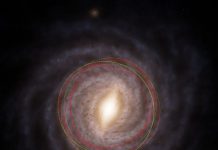
When the first stars in the Universe formed, the only material available was primordial hydrogen and helium from the Big Bang.
Astronomers call these original stars Population Three stars, and they were extremely massive, luminous, and hot stars. They’re gone now, and in fact, their existence is hypothetical.
But if they did exist, they should’ve left their fingerprints on nearby gas, and astrophysicists are looking for it.
The hunt for the Universe’s Population 3 (Pop III) stars is important in astrophysics. They were the first to form astronomical metals, elements heavier than hydrogen and helium.
Only once these metals were available could rocky planets form.
Their metals also fed into the next generation of stars, leading to the higher metallicity we observe in stars like our Sun.
Since Pop III stars were so massive and hot, they didn’t last long. None would have survived to this day. But the powerful JWST can expand the search for these crucial stars by looking back in time for their ancient light.
That’s what the JWST-JADES (James Webb Space Telescope Advanced Deep Extragalactic Survey) is all about.
Researchers working with JADES data have found tantalizing evidence of Pop III stars in GN-z11, a high-redshift galaxy that’s one of the furthest galaxies from Earth ever observed. Their findings are in the paper “JWST-JADES.
Possible Population III signatures at z=10.6 in the halo of GN-z11.” The lead author is Roberto Maiolino, a professor of Experimental Astrophysics at the Cavendish Laboratory (Department of Physics) and the Kavli Institute for Cosmology at the University of Cambridge. The research will be published in the journal Astronomy and Astrophysics.
“Finding the first generation of stars formed out of pristine gas in the early Universe, known as Population III (Pop III) stars, is one of the most important goals of modern astrophysics,” Maiolino and his colleagues write in their paper.
“Recent models have suggested that Pop III stars may form in pockets of pristine gas in the halo of more evolved galaxies.”
GN-z11 is one such galaxy. At a redshift of z = 10.6034, the JWST sees the galaxy as it existed about 13.4 billion years ago, corresponding to about 400 million years after the Big Bang.
Pop III stars were massive and could be as much as 1000 times more massive than the Sun. These massive stars would’ve been exceptionally hot, which can provide a clue to their presence. Astrophysicists think all that heat could’ve doubly ionized nearby helium.
So they search for the expected signature of that helium: prominent HeII nebular lines called the HeII?1640 emission line. To indicate the presence of Pop III stars, the HeII lines need to be unaccompanied by any metal lines.
The JWST observed the galaxy with its NIRSpec-IFU (Integrated Field Unit) and found a tentative detection of HeII?1640.
Detecting the doubly-ionized helium line was only the first step. Pop III stars aren’t the only objects that could’ve ionized the helium. To determine if the ancient stars were responsible, the researchers examined the galaxy and isolated several features.
Along with the HeII?1640, they also found Lyman-alpha emissions and CIII, or doubly-ionized carbon.
In the images above, the researchers note several features that are clues to the source of the helium ionization.
The HeII emissions show a plume extending to the west of GN-z11. It could be tracing gas photoionized by the galaxy’s active galactic nucleus (AGN.) Since CIII is so weak there, it could indicate very low metallicity gas photoionized by the AGN.
The image also shows a clump of HeII to the northeast of GN-z11. The researchers call this clump the “most intriguing” feature found. They analyzed the clump in the image below.
So what does this all add up to? Did the researchers find Pop III stars?
The spectral feature in the clump is strong evidence of photoionization by Pop III stars, according to the authors. “This wavelength corresponds to HeII?1640 at z=10.600, and it is fully consistent with the redshift of GN-z11,” they write. The same emission was detected over a larger area to the northeast, possibly with a second, fainter clump.
The authors say that the AGN could’ve photoionized the helium close to the galaxy’s center, but it can’t explain the HeII further away. Pop III stars are the best explanation, according to the authors.
Other evidence for Pop III stars comes from the emissions widths of the HeII lines. The high width suggests photoionization by metal poor Pop III stars rather than by Pop II stars with higher metallicity.
The extent of the ionization also indicates a certain mass for the Pop III stars, and the indicated mass agrees with simulations.
There’s another possibility: a direct collapse black hole (DCBH). “We also considered the alternative possibility of photoionization by a DCBH in the HeII clump,” the authors write. But the emission width should be lower in that scenario, although not by a lot. “Hence, this scenario remains another possible interpretation,” the authors write.
If future observations confirm the presence of Pop III stars in GN-z11, that’s a pretty big deal. But even if we have to wait for that confirmation, this research shows how powerful the JWST is again.
“These results have demonstrated the JWST’s capability to explore the primitive environment around galaxies in the early Universe, revealing fascinating properties,” the researchers conclude.
Written by Evan Gough/Universe Today.



